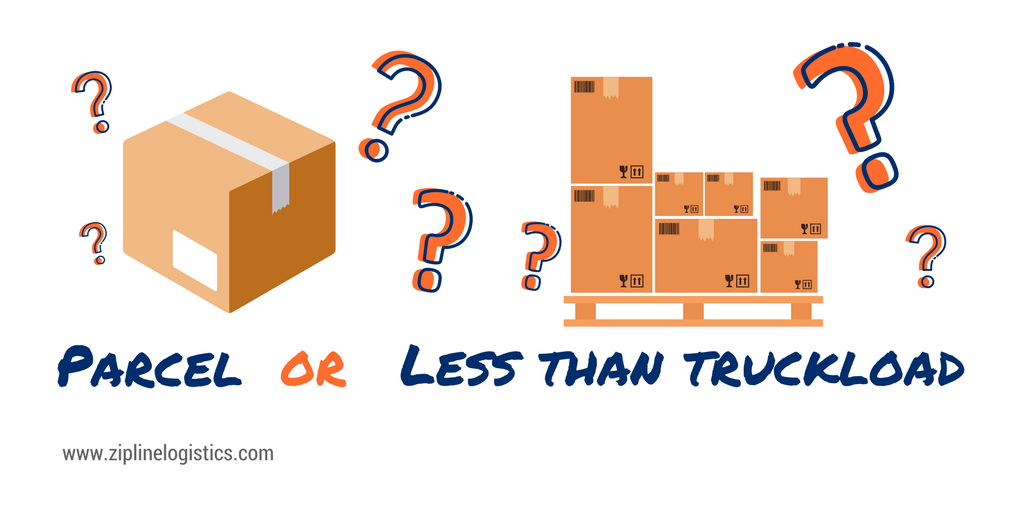More than 25 million small packages, otherwise known as parcels, are shipped daily. Meanwhile, the top 10 commodities shipped tend to be bulky and require less-than-truckload (LTL) shipping. But, the lines between parcel and LTL shipping have started to blur in recent years. Parcel carriers are spending less per shipment, and LTL shippers are spending less by reducing the “work” that goes into shipping.
So, how do shippers know when to choose parcel or LTL shipping to save the most money? To find the answer, shippers need to ask several questions about the shipment.
When to Choose a Parcel Shipment
Is the Package Maneuverable?
Parcels need to be maneuverable; in other words, the package needs to be small enough to be easily managed by one person, explains United Delivery Service. In addition, its weight should not exceed 150 pounds, but some parcel carriers may even place a 70-pound maximum on a parcel shipment. Moreover, small packages must adhere to the dimensional (DIM) pricing requirements.
For example, a package with a total volume more than 166 inches3 may incur a surcharge by the carrier. As of January 1, 2015, the top parcel carriers, including DHL, UPS and FedEx, reports Inbound Logistics, implemented DIM pricing models.
Use a parcel shipment for packages within DIM pricing restrictions and of low weight.
Do You Need Guaranteed, Overnight or Saturday Delivery?
Carriers also have strict stipulations on the availability of guaranteed, overnight and Saturday delivery. Unfortunately, LTL carriers rarely offer these additional delivery options. This is due to the large-scale of each pallet, and LTL carriers may still transfer the package to a parcel carrier in the end, requiring unwrapping and sorting of the LTL shipment. So, what does it mean?
Use a parcel shipment for time-sensitive shipments.
Can Multiple Small Packages Be Combined in Your Facility?
As a shipper in today’s e-commerce-driven world, it is easy to assume small package is the way to go. However, you need to consider the possibility of consolidating small packages heading in a similar direction. If consolidation is possible, it may be better to opt for a LTL-shipping selection.
Do not use a parcel shipment when multiple small packages can be combined into a pallet heading to the same, general destination.
Does the Discounted Rate Really Apply?
Discounted rates play another factor in considering parcel or LTL shipping. Parcel carriers may offer a steep discount in the hopes of getting more orders. However, many parcel carriers may stipulate minimum amounts per parcel within the shipper’s contracts. As a result, a 75-percent discount on a $20 shipment may sound great, but if the minimum is $8, the shipment will actually cost $8 to ship, not $5 after applying the discount.
Select parcel shipping when the minimum rate is below discounted rates with either parcel or LTL shipping.
Do You Have an Upcoming LTL Pickup Scheduled?
Pickup charges can be among the top costs in using LTL shipping. But, you can use that to your advantage. You may be able to save money by consolidating or adding to an existing LTL pallet that already has a scheduled pickup.
Use small-package shipping if you do not have any LTL pickups scheduled and when you cannot consolidate multiple parcels.
Do You Have a Loading/ Unloading Dock at Your Facility and Across Your Supply Chain Locations?
LTL shipments are big, and as such, they require a loading and unloading dock to get from point A to point B. If you lack docks in your facility, or at any other receiving or shipping center in your supply chain, LTL shipping may incur additional costs, including labor costs.
Use parcel shipping when your facilities lack the docks necessary for LTL pickup.
When to Choose LTL Shipping
Do You Need a Lower-Cost Option?
The first reason shippers look at LTL options is about costs. LTL carriers tend to cost less per item than parcel carriers. However, LTL carriers require a bigger shipment to be cost-effective. In addition, accessorial charges may add up quickly in parcel shipping, reports Penny Guyer of Parcel Magazine.
Use LTL shipping when you have palletized, larger shipments that need a lower-cost option or when a parcel carrier’s accessorial charges exceed the LTL shipping cost.
Is the Package Bulky?
Sometimes, there is just no way to send a shipment without bulky packaging, especially among fragile products or items requiring white-glove service. Furthermore, bulky, lightweight items may be subject to DIM pricing models by your parcel carrier, driving up shipping costs.
Select LTL shipping for bulky items, including items requiring extra space with a lower total weight.
Have You Met Your Volume Quota for Discounted LTL Shipping?
LTL shipping relies on volumes to give shippers the best rates possible. Unfortunately, this means that LTL options may only qualify for discounts if the shipper has continually met his or her contractual obligations to ship x amount of volume with a given carrier.
Use LTL shipping if you are on track to meet your volume obligations, getting a discounted rate that’s lower than parcel costs.
Have LTL General Rate Increases Been Implemented?
General rate increases in LTL shipping are not new, but the actual costs of implementation may not necessarily adhere to the carrier’s planned rates. Consequently, general rate increases may exceed the carrier’s announced increases. This impacts your selection too.
Only use LTL shipping if rate increases have already been implemented, providing you can see the finite cost of your shipment.
What Is the Price of Oil Doing?
Last, you need to watch the cost of oil. The per-barrel price of oil indicates how future fuel costs in the next week or two may fluctuate. In turn, changing oil costs impact fuel surcharges for parcel and LTL shipments. So, watching the cost of oil can actually help you predict the monetary impact of fuel surcharges in your shipments.
Use LTL shipping if the cost of oil has been stable, use parcel shipping if oil prices are expected to climb in the upcoming days.
(Bloomberg Markets has a great, real-time graphic showing the current and recent fluctuations in oil costs.)
Parcel and LTL in a Nutshell
While these questions and guidelines can help you select the best shipping option between parcel and LTL shipping, it is important to always remember how things look from the outside. In other words, you may want to consider using a third-party logistics provider 3PL to help you select the best shipping option from among multiple parcel and LTL carriers for your shipments. This will eliminate biases and ensure your company is using the best shipping option for your immediate needs.


